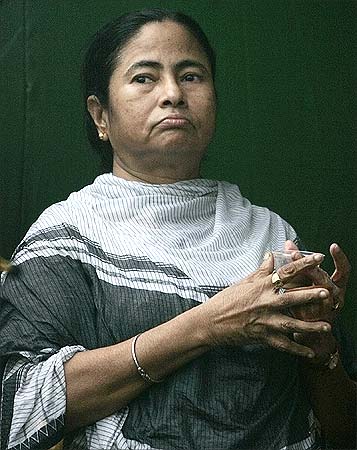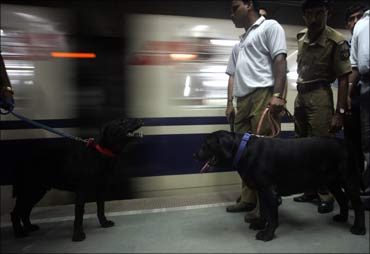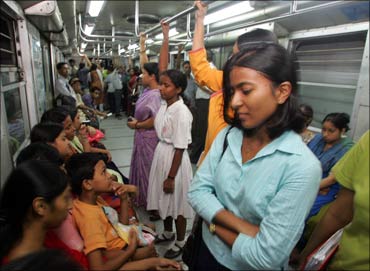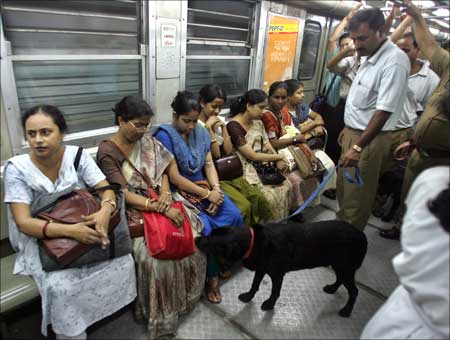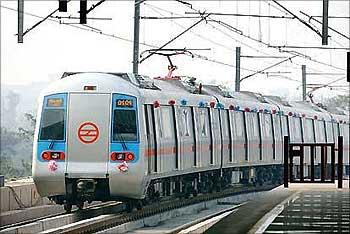 | « Back to article | Print this article |
How Kolkata Metro has suffered being part of Indian Railways
Last month, Delhi Metro Rail Corporation, India's model mass rapid transit system, announced that it was looking to list on domestic bourses to raise funds for expansion.
If it happens, this would be a first for urban transportation organisations in the country.
But its forerunner is floundering. Over 25 years since services first started, Kolkata Metro has disintegrated into a hobbling system marred by decades of neglect and a lack of long-term planning, in part emblematic of Indian Railways, which operates it.
Constant delays, and even a derailment, have begun to mar its usually acceptable record. In October, over 2,000 passengers had to be evacuated after a southbound train was derailed during peak hours. There have also been recurring issues with new air-conditioned coaches.
Click NEXT to read on . . .
How Kolkata Metro has suffered due to Railways
Even as officials scramble to work on crucial components -- including coaches, ticketing and communication systems -- that are in dire need of replacement, it is clear that the railways will need to do a substantial rethink on the future of the only underground MRT system under its purview.
Crumbling components
Last year, after Railway Minister Mamata Banerjee opened the 5.8-km Tollygunge-Garia extension of the Kolkata Metro, which was sanctioned during her previous term almost a decade ago, the sudden spike in ridership -- amounting to at least 1 lakh additional passengers, on top of the usual 5 lakh (500,000) -- caught Kolkata Metro off guard.
Today, the network is fighting to upgrade systems and components that should have been replaced well before the rush began.
Rolling stock, for instance, hadn't seen new introductions until new rakes were brought in this October.
Click NEXT to read on . . .
How Kolkata Metro has suffered due to Railways
But these, too, have been constantly plagued by technical snags. The system continues to mainly function on rakes procured when Kolkata Metro first started operations.
"Planning was done much earlier for new rakes, but certain changes in specifications meant that the designs had to be modified and there was a delay. Two new rakes have already come and they are being stabilised," said Kolkata Metro chief electrical engineer B K Patel.
But others, including Kolkata Metro's first general manager, Himangshu Sinha, felt that the relevant authorities, knowing that the extended section would be opened, should ensured advanced action was taken. Since that hasn't happened, the ageing rolling stock is now in shambles.
"These (old) coaches are being more intensively used and the mid-day maintenance that was done before has evaporated. They are even cannibalising other coaches. The whole thing is about maintenance," Sinha added.
Click NEXT to read on . . .
How Kolkata Metro has suffered due to Railways
In stark contrast, DMRC -- the only other operational metro system in the country -- has seen a calibrated increase in the number of coaches as ridership has increased.
Since 2002, the year of DMRC's opening, the number of trains has gone up from eight to 160, and plans have also been drawn up to introduce six-coach trains from the four-coach rakes presently in use.
But, Kolkata Metro, which serves about 6 lakh passengers daily compared with DMRC's 16 lakh (1.6 million), has only 20 trains, including two new rakes.
Additionally, unlike Kolkata Metro that currently depends on the Railways' Integral Coach Factory for rolling stock, DMRC has roped in international coach makers such as Hyundai Rotem and Bombardier.
Click NEXT to read on . . .
How Kolkata Metro has suffered due to Railways
The situation is no different with the ticketing system. The Railways' information technology arm, Centre for Railway Information Systems (CRIS), had been given the responsibility to upgrade this earlier this year.
Although CRIS had a blueprint ready by February, Kolkata Metro officials are still unable to commit a deadline by which this process would be complete.
In the process, large numbers of passengers are thought to be travelling ticketless through a public transport system that has never made profits.
This, despite the fact that tickets for Kolkata Metro start at Rs 4 a ride up to a maximum of Rs 12 to traverse the entire route.
Click NEXT to read on . . .
How Kolkata Metro has suffered due to Railways
Structural flaws
With a 22-km network and only 21 stations, against the 156-km network of DMRC, Kolkata Metro is the smallest of the MRT systems in the country.
According to Dilip Halder, a former professor of transport economics at Jadavpur University, it was planned as part of a much larger matrix of MRT systems, including an east-west line and another on the north-south axis.
But apart from the Calcutta Mass Transit System of 1971, Halder claims the railways did not have any other long-term strategic plan for Kolkata Metro.
"But even the Calcutta (Mass) Transit Study was not followed properly," he added.
Click NEXT to read on . . .
How Kolkata Metro has suffered due to Railways
Work on the east-west line only started last year as a joint venture between the West Bengal government and the Union urban development ministry. Plans for another north-south line have been put on the backburner.
Kolkata Metro has also suffered by virtue of being part of Indian Railways. As one of the most localised arms of the railways, with its own general manager, the network has suffered from bouts of negligence from disinterested ministers.
"It has faced step-motherly treatment from previous railway ministers, as Kolkata isn't important for them," contended Halder.
Tapas Mukherjee, general secretary of the Metro Railway Workers' Congress, alleged that since Kolkata Metro had never earned the Rail Board any money, the apex decision-making body of the railways hadn't paid enough attention to the network.
Click NEXT to read on . . .
How Kolkata Metro has suffered due to Railways
Another problem of being part of the Indian Railways has been inordinate movement at the very top. Kolkata Metro has had over ten general managers in the same number of years.
"Too many changes at the top have not allowed the necessary improvements to the system. It can't be overlooked," said Sinha.
The railways has been kept out of all other metro projects in the country. While DMRC and Bangalore Metro are operating as special purpose vehicles with equity participation of the Centre and respective state governments, Hyderabad Metro is an Andhra Pradesh government enterprise that will undertake the project on a build-operate-transfer basis.
However, with West Bengal's chief ministerial contender as the incumbent railway minister, Kolkata Metro is squarely back in the spotlight, which might translate into more funds and better officers for the system.
Click NEXT to read on . . .
How Kolkata Metro has suffered due to Railways
The problems of this ageing network, though, are unlikely to disappear in a hurry, as Banerjee is slowing but steadily finding out.
As DMRC managing director E Sreedharan, who also worked on the Kolkata Metro project, pointed out, "Indian Railways built Kolkata Metro using railway technology, not metro technology. It doesn't have much of a future unless the system is upgraded and modernised completely."
Evidently, Kolkata Metro's problems started right at the beginning. But unless Indian Railways acts quickly and decisively now, the only underground Metro system under its administration will continue hurtling down troubled tracks.

